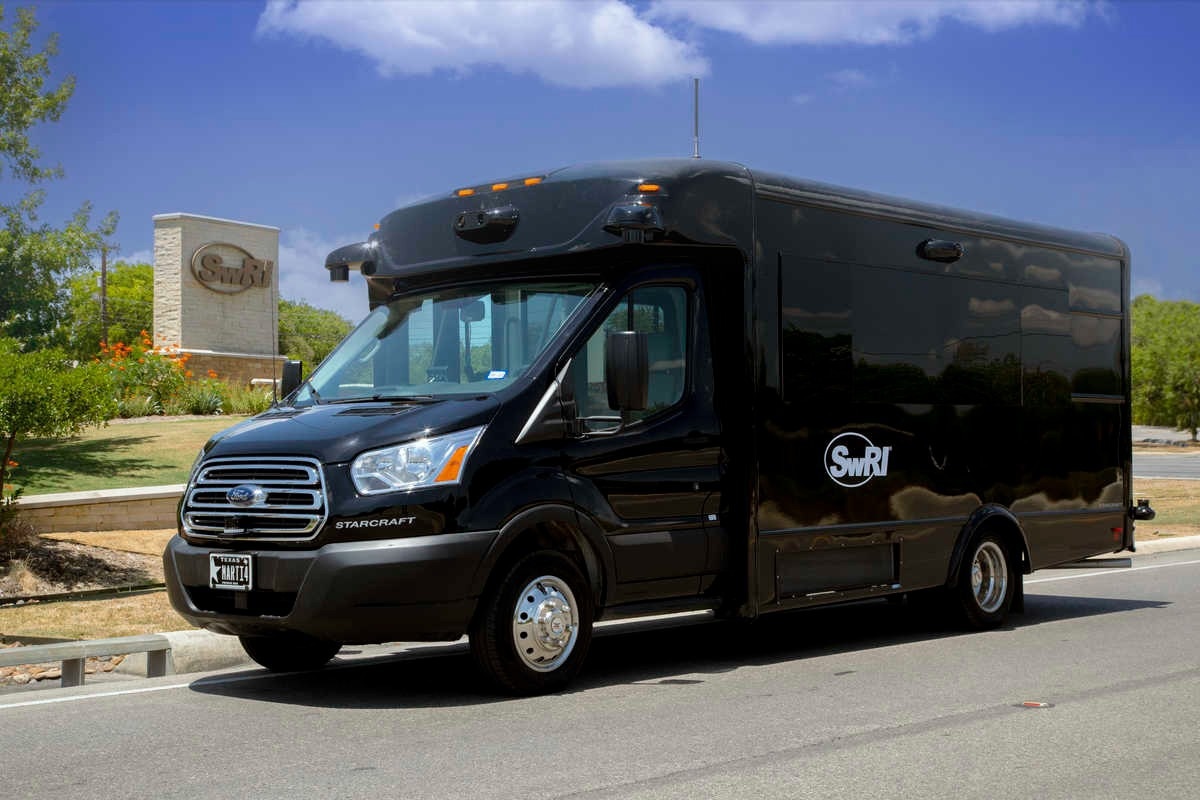An automated shuttle has been installed on the 1,500-acre campus of Southwest Research Institute, a pioneer in the development of software and systems integration for robots and automated vehicles.
 Southwest Research Institute’s automated shuttle is a 14-passenter, self-driving transport vehicle equipped with lidar, camera sensors and machine vision algorithms that enable automated driving. The shuttle autonomously navigates campus tours on pre-programmed routes, but a human driver is always behind the steering wheel for added safety. Image Credit: Southwest Research Institute.
Southwest Research Institute’s automated shuttle is a 14-passenter, self-driving transport vehicle equipped with lidar, camera sensors and machine vision algorithms that enable automated driving. The shuttle autonomously navigates campus tours on pre-programmed routes, but a human driver is always behind the steering wheel for added safety. Image Credit: Southwest Research Institute.
The shuttle, which can carry up to 14 passengers, is equipped with algorithms, sensors, cameras, and software created by SwRI through in-house research.
It is rewarding for our engineers to take the very best technology that SwRI has developed to serve our clients and then embed it into a showcase vehicle that has a practical purpose in our backyard.
Ryan Lamm, Director, Applied Sensing Department, Southwest Research Institute
The vehicle has been designed to independently travel distinct paths around the premises using SwRI’s Ranger technology. Ranger is a localization tool that can retain its location to within 2 mm along a defined route using a ground-facing camera and automation software. As an added safety precaution, a human operator operates the vehicle while seated behind the wheel.
Driverless, fully automated vehicles are still several years away, but this shuttle proves that we are well on our way to such a future.
Steve Dellenback, Vice President, Intelligent Systems Division, Southwest Research Institute
With a top speed of less than 50 mph, the shuttle is categorized as a low-speed vehicle (LSV), making it perfect for closed campuses like the SwRI headquarters or highways with reduced speed limits. It makes use of a campus map generated in the Ranger system, complete with crosswalks, stop signs, and junctions. The operator chooses routes along the map in real-time.
It also includes artificial intelligence (AI) to categorize objects like pedestrians, automobiles, traffic signs, and other objects. The shuttle has been programmed by SwRI to handle a variety of driving situations, including sharing the road with other cars, seeing moving objects like bicycles and pedestrians, and identifying who has the right-of-way at crossings.
The shuttle collects data every time it is on the road, allowing us to continually refine its algorithms to improve reactions in various situations.
Alexander Youngs, Senior Research Engineer, Southwest Research Institute
Youngs spearheaded the development of the shuttle.
SwRI’s autonomy stack, a collection of technologies incorporating custom machine learning algorithms, software and processing tools, cameras, and sensors, is responsible for the majority of the shuttle’s operation.
The ability to integrate and exchange data with autonomous and connected cars as well as with intelligent transportation networks is one of the additional features. A convoy of comparable vehicles can be used to deploy the shuttle, improving mobility while taking traffic and congestion into account.
The shuttle technology has been developed by SwRI for more than a year. At an event that SwRI sponsored in conjunction with Leadership SA, the San Antonio Chamber of Commerce, and the San Antonio Hispanic Chamber of Commerce on August 3rd, 2022, the team presented the automated shuttle to leaders from the San Antonio region.
On the shuttle, attendees were given a 10-minute campus tour where they learned about the computer hardware and operating system.
This mid-size passenger vehicle presents future opportunities to improve mobility and access to transportation in neighborhoods where large busses cannot travel. We are thrilled to be able to say San Antonio not only has this capability at SwRI, but that we are helping to develop and deploy similar systems around the globe.
Dan Rossiter, Engineer, Southwest Research Institute
Since the shuttle is a functional research platform, SwRI is able to develop new automation technologies and add them to the vehicle. It continues to act as a test site for various pilot projects for government and industry clients looking to deploy similar shuttles on both restricted campuses and open roadways, in addition to functioning as a working tour shuttle.